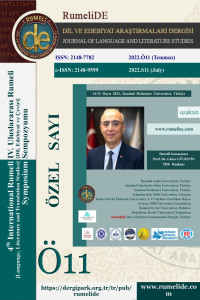Abstract
Doğuştan gelen ve bireyin biyolojik olarak sahip olduğu kadınlık ve erkeklik cinsiyeti daha sonra yaşam içerisinde aile yaşamı, sosyal çevre, ekonomik ve kültürel yapı vb. tarafından şekillendirilerek bir kimlik haline dönüşür. Bu kimliklerin inşasındaki eşitsizlikler olarak tanımlayabileceğimiz toplumsal cinsiyet eşitsizliği günümüzde toplumlardaki sosyal, ekonomik, kültürel, politik ilerlemelere rağmen artarak devam etmektedir. Geleneksel medya olarak tanımlanan radyo, televizyon ve gazetelerde, yeni medya olarak tanımlayabileceğimiz sosyal medya ağlarında da kadına yönelik cinsiyetçi söylemlerle sıklıkla karşılaşılmaktadır. Sosyal ağlar, kimi zaman, söz konusu bu cinsiyetçi söylemleri belli başlı sözceleme stratejileri ve olanakları ile cinsiyetçi söylemin hedefi ve nesnesi olan kadını değil onun karşı cinsi olan erkeği söylemin nesnesine dönüştürebilir. Çalışmanın konusu bu söylem ve sözceleme stratejilerini incelemektir. Bütüncemizi, 7 Haziran 2020’de twitter’da #erkekyerinibilsin etiketiyle başlatılan; geçmişten günümüze dilimize yerleşmiş, kadına yönelik cinsiyetçi söylemler içeren, sıradanlaşmış atasözlerini, deyimleri, maço söylemleri tersine çevirerek erkeklere yönelik uyarlanmasıyla başlayan ve kendiliğinden bir akıma dönüşen tweetler oluşturmaktadır. Akım çerçevesinde üç gün boyunca iki bini aşkın tweet atılmıştır. Çalışmada, bu tweetlerden 90 tanesi incelenmiştir. Eril bakış tarafından tanımlanan kadın kimliğini ifade eden bu söylemlerin çok sesli sözcelem biçimi olan tersinleme ile (Fr. ironie) tersine çevrilmesi yeni bir anlam ve kimlik inşasının da oluşmasına yol açmıştır. Seçilen tweetler kendi içlerinde dilsel yapı, işlev ve değer açısından sınıflandırılmıştır. Eril kültür tarafından tanımlanan kadın kimliğinin anlam alanları dilbilimsel ve anlambilimsel yöntemle çözümlenmiştir. Kadın kimliğini cinsiyetçi söyleme dayanarak tanımlayan söylemlerin tersine çevrilmesiyle elde edilen yeni söylemlerdeki değişkenler sözcelemsel olarak incelenmiş, sözceleme öznesinin karşıt bir kimlik inşa ederken aslında kendi kimliğini de kurduğu ortaya konulmuştur.
References
- Akarsu, B. (1998). Dil-Kültür Bağlantısı, Ankara: İnkılâp Yayınevi.
- Aksan, D. (1993). Türkçenin Gücü, Ankara: Bilgi Yayınevi.
- Anscombre, J.-C., Darbord, B. Et Oddo, A. (2012). La parole exemplaire, Paris: Armand Colin.
- Charaudeau P. (2009). Identité sociale et identité discursive. Un jeu de miroirfondateur de l’activité langagière, in Charaudeau P. (dir.), Identités sociales et discursives du sujet parlant, 2009, Paris: L’Harmattan http://www.patrick-charaudeau.com/Identite-sociale-et-identite.html#
- Del Ré, A., Hirschi, F., ve Dodane, C. (2018). L’ironie dans le discours : des premières productions enfantines aux productions des adultes, Cahiers de praxematique, numéro 70, https://doi.org/10.4000/praxematique.4796, [son erişim tarihi, 19.06.2022].
- Korkut, E. (2017). Söz ve Kimlik, Söylemler Bize Ne Söyler? Ankara: Seçkin Yayıncılık.
- Mercier-Léca, F. (2003). L’ironie, Paris: Hachette.
- Onursal Ayırır, İ. ve Korkut, E. (2017). Prof. Dr. Ayşe Eziler Kıran’a Armağan, Ankara: Hacettepe Üniversitesi.
- Öztin Passerat, D. (2014). Siyasal Söylemde Tersinleme, Humanitas, cilt.2 sayı. 4: Tekirdağ. 207-224.
Abstract
Congenital and biological femininity and masculinity of the individual, later in life, family life, social environment, economic and cultural structure, etc. It turns into an identity by being shaped by it. Gender inequality, which we can define as the inequalities in the construction of these identities, continues to increase despite the social, economic, cultural and political advances in societies today. Sexist discourses against women are frequently encountered in radio, television and newspapers, which are defined as traditional media, and in social media networks, which we can define as new media. Social networks can sometimes turn these sexist discourses into the object of discourse, not the woman, who is the target and object of the sexist discourse, but the man, who is the opposite sex, with certain enunciation strategies and possibilities. The subject of the study is to examine these discourse and enunciation strategies. Our corpus was launched on Twitter on June 7, 2020 with the hashtag # Erkekyerinibilsin; It creates tweets that have been ingrained in our language from past to present, containing sexist discourses towards women, reversing ordinary proverbs, idioms, macho discourses, and adapting them to men and turning into a spontaneous trend. Within the framework of the movement, more than two thousand tweets were sent over three days. In the study, 90 of these tweets were examined. The reversal of these discourses, which express the female identity defined by the masculine point of view, with the polyphonic utterance form inversion (Fr. ironie), has also led to the formation of a new meaning and identity construction. Selected tweets are classified in terms of linguistic structure, function and value. The semantic fields of female identity defined by masculine culture have been analyzed with linguistic and semantic methods. The variables in the new discourses, which are obtained by reversing the discourses that define female identity based on sexist discourse, are analyzed enuncially, and it is revealed that the enunciation subject actually establishes his own identity while constructing an opposing identity.
References
- Akarsu, B. (1998). Dil-Kültür Bağlantısı, Ankara: İnkılâp Yayınevi.
- Aksan, D. (1993). Türkçenin Gücü, Ankara: Bilgi Yayınevi.
- Anscombre, J.-C., Darbord, B. Et Oddo, A. (2012). La parole exemplaire, Paris: Armand Colin.
- Charaudeau P. (2009). Identité sociale et identité discursive. Un jeu de miroirfondateur de l’activité langagière, in Charaudeau P. (dir.), Identités sociales et discursives du sujet parlant, 2009, Paris: L’Harmattan http://www.patrick-charaudeau.com/Identite-sociale-et-identite.html#
- Del Ré, A., Hirschi, F., ve Dodane, C. (2018). L’ironie dans le discours : des premières productions enfantines aux productions des adultes, Cahiers de praxematique, numéro 70, https://doi.org/10.4000/praxematique.4796, [son erişim tarihi, 19.06.2022].
- Korkut, E. (2017). Söz ve Kimlik, Söylemler Bize Ne Söyler? Ankara: Seçkin Yayıncılık.
- Mercier-Léca, F. (2003). L’ironie, Paris: Hachette.
- Onursal Ayırır, İ. ve Korkut, E. (2017). Prof. Dr. Ayşe Eziler Kıran’a Armağan, Ankara: Hacettepe Üniversitesi.
- Öztin Passerat, D. (2014). Siyasal Söylemde Tersinleme, Humanitas, cilt.2 sayı. 4: Tekirdağ. 207-224.
Details
| Primary Language | Turkish |
|---|---|
| Subjects | Linguistics |
| Journal Section | World languages, cultures and litertures |
| Authors | |
| Publication Date | July 21, 2022 |
| Published in Issue | Year 2022 Issue: Ö11 |


